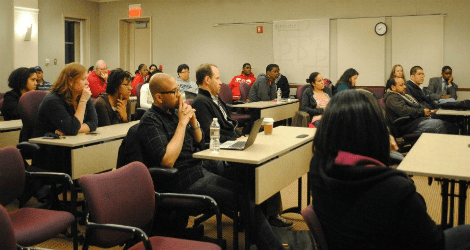Princeton Theological Seminary
In hasty attempts to have healthy communities now, institutions engage conflict-avoiding diversity practices that often ignore topics such as privilege and hegemony, because such discussions create tension and discomfort. But, tension and discomfort for whom?
By Josh Newton View and print as PDF.
View and print as PDF.
Princeton Theological Seminary (PTS) has historically graduated students concerned with issues of social justice. Francis Grimké was a member of the Niagara Movement (an African American civil rights organization dating back to 1905) and helped found the NAACP. Theodore S. Wright became the first African American to graduate from a theological institution in the United States in 1929; he also was a founding member of the American Anti-Slavery Society. James Reeb, a civil rights activist, was beaten to death in Alabama fighting for justice.
Undoubtedly, Princeton Theological Seminary has historically produced conscious graduates, but what is the state of social justice on the seminary campus today? What are students, faculty, and administration doing to heed the call to justice now?
Students at PTS remain attentive to social justice issues through multiple organizations. The Asian Association of Princeton Theological Seminary, Association of Black Seminarians, and Association of Latin@ Seminarians advocate racial justice; The Women’s Center and Bisexual, Gay, Lesbian and Straight Supporters advocate gender and sexual justice; Environmentally Conscious Organization of Seminarians advocate environmental justice; and Seminarians for Peace and Justice advocate local, national, and global justice. Organizing in these groups has allowed students to hold the larger seminary community—including faculty and administrators—accountable to the concerns of its underrepresented groups. As an example, last year the Association of Black Seminarians urged administrators to add a provision to the student handbook outlining actions to be taken in the event of racial discrimination. For the first time in two hundred years the seminary has a process outlined for protecting students of color and holding faculty, administration, and students accountable to equal treatment for all. And yet, there are struggles that continue.
___________________________________________
The result is homogenized diversity; in attempting to unify diverse populations around a certain value, “what is best” for the community is often articulated by those already in power.
___________________________________________
I am on the executive board of the Association of Latin@ Seminarians and am part of the continued struggle for a Latino/a faculty member. In the history of the seminary there has been only one Latino faculty member hired—Luis Rivera-Pagán—and that was by presidential appointment (though this occurred only through pressure from a faculty committee). Since the departure of Rivera-Pagán from the seminary, there has not been another Latino/a scholar hired, leaving a void for Latino/a students and, one could argue, for the seminary community as a whole (there are Latino/Hispanic staff; PTS is also home to the important Hispanic Theological Initiative).
Many Latino/a students feel the lack of a Latino/a scholar on campus creates multiple deficiencies in their experience as seminarians. A Latino/a scholar would likely be more aware of the breadth of Latino/a scholars and scholarship, making him or her more able to cultivate Latino/a students’ theological thinking. That scholar would be aware of, and sensitive to, the difficulties and challenges of the academy for Latino/a students. He or she could share in the life experiences unique to many Latino/as, helping to develop and implement curriculum both intelligible and relevant to those experiences. Possibly of most importance, a Latino/a faculty member gives rising church leaders and academics hope that their unique perspective is accepted and celebrated by the church and academy.
In summary, Latino/a students are lacking an effective mentor. But Latino/a students are not the only students who suffer from this deficit. The population of the United States is increasingly Latino/a, and therefore churches and classrooms are increasingly Latino/a—a community our seminary students are not prepared to meet, in either understanding or ministry. While some new pastors will invariably adapt and learn, many will not, meaning entire subsets of our church and neighborhood communities will go (and in fact often already are) neglected, if not overtly excluded.
That being said, there are professors at Princeton Theological Seminary addressing matters of justice in their curriculum. Dr. Yolanda Pierce teaches courses on African-American religious history and womanist theology. Dr. Mark Taylor directs attention to the multifaceted nature of injustice and oppression through classes on race, gender/sexuality, class and empire, and incarceration. Multiple scholars—including Dr. Jacqueline Lapsley, Dr. Katherine Sakenfeld, and Dr. Kathleen McVey—teach courses attending to the place of women in the global, historical church. I am sure there are other classes, as well, of which I am unaware.
Despite these enclaves of justice-focused classes and professors, the curriculum as a whole is lacking in its diversity of perspectives. Students such as myself often take classes and find a complete absence of underrepresented voices. When readings from those voices are on the syllabus, they are often marginalized to the “recommended reading” section, instead of being considered worthy to be placed in the required reading section alongside the voices of white, heterosexual men.
This problem is not distinctive to the faculty though; the administration of Princeton Theological Seminary is often slow to react to injustice on campus, despite some changes in the last few years. It would be remiss of me, in writing an essay on the environment for social justice on campus, not to mention an event from last year. In the 2011-2012 academic year, a pro-life campaign distributed flyers throughout the seminary campus that contained what many considered to be racist propaganda. It was ignored until the Association of Black Seminarians, through an organized movement, forced faculty and administrators to deal with the issue. A result of this movement is the diversity initiative presently in place at PTS, “Navigating the Waters.” While diversity is unquestionably a move in the right direction, it does not address the complexity of the problem. I will suggest shortcomings common to diversity initiatives by commenting on statements of the purpose of “Navigating the Waters” from the seminary’s website.
Princeton Theological Seminary endeavors to model for the academy and the worldwide church a community of individuals who seek what is best for each other.
Because diversity initiatives commonly attempt to meet quotas or curtail legal punishment and community unrest, they fail to address historical privilege and hegemony of white, heterosexual men. They act as a quick fix to a long-established, complex obstacle. Taking Princeton Theological Seminary as an example, “Navigating the Waters” is a three-to-four year program to address problems that span centuries. In hasty attempts to have healthy communities now, the institution engages conflict-avoiding practices that often ignore topics such as privilege and hegemony, because such discussions create tension and discomfort. But, tension and discomfort for whom?
The result is homogenized diversity; in attempting to unify diverse populations around a certain value, “what is best” for the community is often articulated by those already in power. Instead of giving volume to those voices that have been silenced, those voices are muted for the benefit of “what is best” for the group.
The Seminary respects and significantly benefits from diversity as expressed through racial/ethnic, gender, cultural, disability, age, sexual orientation, religious/denominational, and socioeconomic differences among faculty, staff and students.
Instead of addressing racism/xenophobia, sexism, nationalism, and homophobia (which are viewed as negative), diversity initiatives often focus on the more positive, less threatening idea that diversity offers the community benefits. Inadvertently, this ignores the pain present on campus, again in an attempt at unity. Students from underrepresented groups are forced to stifle their pain and are made into “tokens” that represent their respective groups for the benefit of the privileged group. In the end, equality is not fostered, but rather those viewpoints tend to be understood as “other” to the common paradigm.
It takes seriously its responsibility to offer educational and professional opportunities equitably to all qualified persons.
Again, by not being critical of history, diversity initiatives commonly overlook institutionally embedded assumptions. In this case, the term “qualified” carries with it a politicized agenda, even if unacknowledged or unintended. How is a person deemed to be qualified? The term is often placed at odds in today’s political and institutional rhetoric with diversity initiatives. Affirmative action has suffered significant setbacks in our society because of this rhetoric. Despite claims of objectivity, those in power have determined the definition of “qualified”, and their preferences are unavoidably implicated. Thus, white, heterosexual men are regularly going to be considered qualified, while others are considered an attempt to meet a quota. White, heterosexual men are then painted as victims of diversity initiatives.
The Seminary through its curriculum, programs, and services, endeavors to provide understanding and supportive interaction among diverse population groups and respects individuals’ personal values and ideas.
Lastly, diversity initiatives tend not to take a stand against any way of thinking—rejection of an idea is seen as antithetical to inclusivity. But in working toward justice, we are obligated to preserve the tension between necessary free discourse and the equally necessary assumption of a moral and unequivocal stance against oppression and its ideologies. Justice, while formative for the purposes of long-term reconciliation, often requires initial division and conflict.
Again, I think diversity initiatives are a step in the right direction, but in understanding our call to justice in the church and academy, it is not good enough. What good is diversity in curriculum if underrepresented voices are relegated to “recommended reading” lists? What good is having a diverse faculty, if underrepresented voices are seen as meeting a quota, and thus not particularly “qualified” enough? What good is a diverse community if underrepresented students are forced to fight for their grades, because their ideas are not considered to be mainstream enough? No, diversity is not equivalent to equality, let alone justice.
This is my concern not just for Princeton Theological Seminary, but also for the Church, the academy, and our nation. In the post-Civil Rights era, we tend to think that we have arrived—that we have overcome the problems of the past. Diversity initiatives can act as a way to prove how far an institution has come without actually addressing the reality and root of the problems. My hope for PTS, the Church, the Academy, and the nation is that we start to have the difficult conversations that are historically critical and often times painful. My hope is that we work not only toward diversity, but even more, toward equality and justice.
________________
Josh Newton is a second year Master of Divinity student at Princeton Theological Seminary. He plans to continue his education through doctoral studies and hopes for a career in the academy. His research focuses on whiteness studies, critical race theory, and religion.









Pingback: Five Articles on Social Justice from Princeton Theological Seminarians | Mystic Modern – Spirituality, Science, Humanity
Pingback: Ave verum corpus, natum « Black Nights, White Days – a Bipolar Seminarian